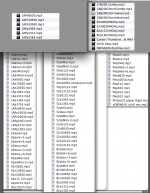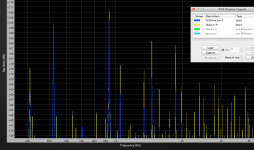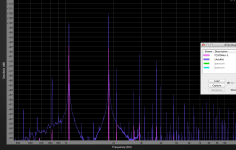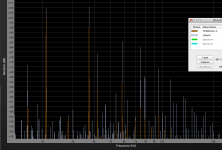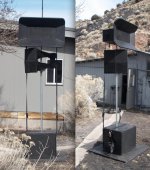Zoran,which program do You use for measurements - some Mac osx ?
I use Smaart V6 (2007) (it runs on Mac or Windows) on a MacBook running OSX 10.4.11 for testing.
There are some glitches running Smaart V6.1 (2008) on my mid 2011 iMac OSX 10.8.4.
I was told the new version of Smaart has been updated to run properly on newer computers.
Art
Hi Bill. I've come back to your big test to have a closer look at what happens harmonically when the compression drivers are pushed. I hear the roughness a lot on P.A.s, so am interested in what may be going on with the distortion spectra as drive levels go up.
Might need some help as to which files to analyze. Basically just want to look at the spectrum at a low level, then at one or two higher drive levels. Will start digging, but would not mind if you chime in.
Might need some help as to which files to analyze. Basically just want to look at the spectrum at a low level, then at one or two higher drive levels. Will start digging, but would not mind if you chime in.
Pano,Hi Bill. I've come back to your big test to have a closer look at what happens harmonically when the compression drivers are pushed. I hear the roughness a lot on P.A.s, so am interested in what may be going on with the distortion spectra as drive levels go up.
Might need some help as to which files to analyze. Basically just want to look at the spectrum at a low level, then at one or two higher drive levels. Will start digging, but would not mind if you chime in.
Who's Bill?
Probably the dual sine wave tests in post #2 would be the easiest to analyze, but the music HF only in the first three posts here:
https://soundforums.net/threads/4329-High-Frequency-Compression-Driver-Evaluation#post
are quite interesting.
At least they were to me 3 years ago ;^)...
Art
I dunno why I said Bill.  Sorry.
Sorry.
The dual sines are what I've run thru analysis, but it seems you did only two drive levels on those, right? A first level and then +6dB. The music clips are good for hearing what's going on, but I think would be hard to analyze for distortion.
 Sorry.
Sorry.The dual sines are what I've run thru analysis, but it seems you did only two drive levels on those, right? A first level and then +6dB. The music clips are good for hearing what's going on, but I think would be hard to analyze for distortion.
Pano,The dual sines are what I've run thru analysis, but it seems you did only two drive levels on those, right?
The first post shows all the tests, there are a lot more than two drive levels tested, but I only converted two drive levels from the Redbook CD recordings to MP3 for the posts.
Art
Pano,Ah ha! Do you by any chance still have those test files? Single or dual tones at differing drive levels? Fingers crossed.
At the top of the list below, the recordings with a black box are still available.
The list below are the MP3 conversions made, but at some point I threw out those other than at the top of the list.
I still have the physical Redbook CD recordings (somewhere..), if you wanted to do some work they would have better detail than the MP3 files.
Art
Attachments
Pano,Thanks Art. Whatever you've got with pure tones at different drive levels. Would be nice to see 2 or 3 drivers, as a comparison. I might look at wav vs MP3 to see if spectrum analysis is any different. If it's close, then MP3 would be OK.
Sounds like all the pure tone stuff I have converted to MP3 has already been posted. If you are interested in more than what is already posted, PM me and I could arrange to get you the original CDs.
Art
Chris,Bumping this again, as I've got a love-hate relationship with my DH1a drivers. Love the sound, hate the weight. Art, are you still running yours, or has something cute and neodymium-based replaced them?
Cheers
Chris
Sold the 10 Paraline cabinets using DH1AMT-16, have one DH1A-16 for sale on a JBL potato masher. Make a perfect center fill for you ;^).
As Ernie mentioned, the 35 pound (total) SynTripP is using the 3.7 lb. Celestion CDX14-3050.
Art
Perfect centre fill indeed 
Would need a boat to itself, though.
That Celestion looks the business. The ferrite version comes in at 60% the price, and still half the weight of the DH1a. Very tempting. Once I've got myself a paying job I'll think about grabbing a pair.
Actually, your SynTripP also uses a pair of 10"s a side, and I've got a set of four very nice Faital Pro 10"s. Coincidence?
Chris
Would need a boat to itself, though.
That Celestion looks the business. The ferrite version comes in at 60% the price, and still half the weight of the DH1a. Very tempting. Once I've got myself a paying job I'll think about grabbing a pair.
Actually, your SynTripP also uses a pair of 10"s a side, and I've got a set of four very nice Faital Pro 10"s. Coincidence?
Chris
I just spent a few days with the Celestion CDX1-1747. To make a long story short, these drivers are not as flat as the charts would have you believe. I did a direct cable swap between them and a pair of DH1a-8's with the same crossover and CD compensation and the DH1a's were much more enjoyable and natural.
How does the Celestion CDX14-3050 compare to the DH1a?
How does the Celestion CDX14-3050 compare to the DH1a?
Last edited:
Pano,Hurray! I know you've been working hard on this big test. There is a lot to digest here.
Will take some time to go thru it all.
EDIT: At first listen to the dual sines, the B&C DE82TN is the only one that sounds clean at all.
As it turns out, the dual sine waves really reveal something I failed to catch in the initial 2012 tests, the upper intermodulation distortion (the addition of two fundamental frequencies, 523 + 932 creating a third frequency of 1455, etc.) had been mistaken for ordinary order upper harmonics, resulting in (consistently) under reporting distortion %.
Recent testing of a 3.5" Tymphony TC9FD-18-08 "full range" driver on the same horn found that it had far less IM distortion than the compression drivers, though is not capable of quite as much high frequency output due to less power handling and lower sensitivity.
The tests below (at two meters, add 6 dB for equivalent one meter SPL) show the TC9 has much lower IM distortion than the best of the compression drivers tested, the DH1A.
On 12/13/15 I did an A/B listening test between the TC9 and the (relatively) new Eminence N314T-8 (3" diaphragm 1.4" exit), both on my Maltese 13 x 13 degree conical horns. Although the N314T-8 had less HF distortion than any of the HF drivers previously tested, the TC9FD was cleaner sounding. The TC9FD has far more clean output capability in the 500 Hz range than any HF driver I've tested, though my listening test was using a steep crossover at around 900 Hz.
The TC9FD required more power than the compression driver, but I was amazed at the clarity at the high SPL levels I worked up to. I'm fairly used to the distortion level in speakers telling when to back off power, but the TC9FD gave almost no indication of distress until the voice coil melted the glue off the former and it "gaacked" out over about a 1 second period.
Prior to the TC9FD letting out the magic smoke, it had survived several songs averaging 120 dBA slow at one meter, with peaks of up to 126 dBA. The driver is only rated for 30 watts (IEC 2685, 6 dB crest factor pink noise) so considering the SPL, amazing that it lasted as long as it did, considering peak levels were well in excess of 200 watts.
On the basis of those tests, used eight Maltese horns to make four dual units that can either be used across the downstage lip as center fill, or in quad arrays left and right.
Although the polar response of a quad array of TC9/Maltese horns is not quite as good as hoped for, they make a fine center fill under the SyntripP cabinets, and have plenty of clean output down to 200 Hz to not require additional woofers for the application.
Art
Attachments
- Status
- This old topic is closed. If you want to reopen this topic, contact a moderator using the "Report Post" button.
- Home
- Loudspeakers
- Multi-Way
- High Frequency Compression Driver Evaluation
